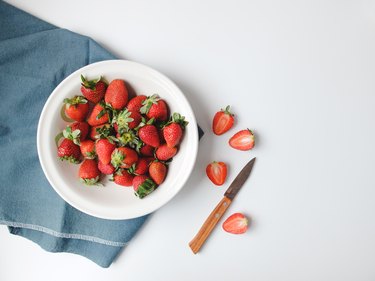
Fresh strawberries in season are a delectable harbinger of summer — plump, juicy and aromatic. But bad strawberries are the complete opposite. Evidenced by berries that are soft, soggy or obviously spotted with mold, they can ruin a fruit salad or shortcake and even make you sick.
Strawberry Benefits
Video of the Day
A Texas A&M University publication lists criteria for selecting strawberries when shopping and details the symptoms of strawberries that are unfit for consumption. Bad strawberries are ones that are mushy, damaged, leaking juice, shriveled or moldy. You should also pass over strawberries that are poorly colored, have large white or green areas or sport dry, brown caps.
Video of the Day
When shopping for strawberries, choose those that have a bright, even, red color, a fresh aroma and an intact, healthy, green cap. Moldy strawberries or overripe strawberries should always be avoided.
Strawberries are believed to contain many health benefits. A May 2015 review in the journal Food and Function cites strawberries as containing phenolics — natural compounds with antioxidant and antimicrobial activity — that are able to detoxify free radicals by blocking their production. Phenolics also serve as an antioxidant defense that protects against and repairs DNA damage.
In addition, according to the USDA, strawberries are high in Vitamin C. A 1-cup serving of whole fresh strawberries contains 85 milligrams of the essential vitamin. Strawberries also contain a good amount of potassium, with the same 1-cup serving containing 220 milligrams of the mineral, and are a source of magnesium, dietary fiber and folate.
Food Safety Concerns
According to the U.S. Food and Drug Administration (FDA), when fresh produce is cut — for example, when you remove the caps from your strawberries — it increases the risk of bacterial growth and contamination by breaking the natural exterior barrier of the fruit or vegetable. The release of plant cellular fluids when produce is chopped or shredded provides a nutritive medium in which pathogens, if present, can survive or grow.
At home, the FDA advises following certain guidelines when preparing fresh produce, including strawberries. First, choose produce that isn't bruised or damaged, and make sure that pre-cut items are either refrigerated or kept on ice both in the store and at home. When preparing fresh produce make sure to:
- Wash your hands for 20 seconds with warm water and soap before and after preparing fresh produce.
- Cut away any damaged or bruised areas before preparing or eating.
- Rinse produce prior to peeling it, so dirt and bacteria aren't transferred from the knife onto the fruit or vegetable.
- Gently rub produce while holding under plain running water — you don't need to use soap or a produce wash.
- Scrub firm produce such as melons or cucumbers with a clean vegetable brush.
- Dry produce with a clean cloth or paper towel.
While it's easy to skip buying moldy strawberries and otherwise bad strawberries by sight, the strawberries you do take home should be kept in the fridge unless you plan to eat them immediately. Strawberries should be washed under running water in a colander just before eating, according to the Texas A&M publication.
However, you should not wash strawberries and then keep them in the fridge, as this can lead to spoilage. If you slice your strawberries, make sure to eat them within two hours; if you don't, store in the fridge and discard after two days if they are not consumed.
- FDA: "Guidance for Industry: Guide to Minimize Microbial Food Safety Hazards of Fresh-cut Fruits and Vegetables"
- Texas Cooperative Extension, Texas A&M University: "Safe Handling of Fresh Strawberries"
- Food and Function: "Strawberry as Health Promoter: An Evidence-Based Review"
- USDA: "Strawberries, raw"